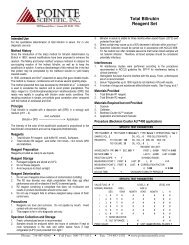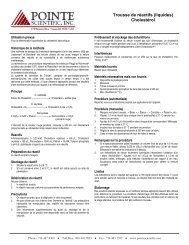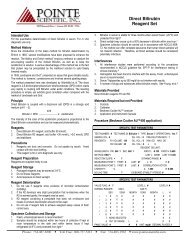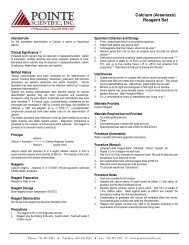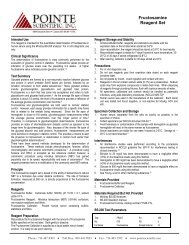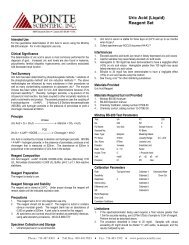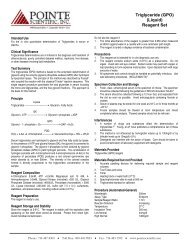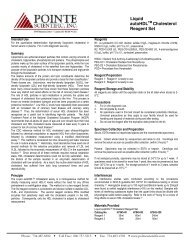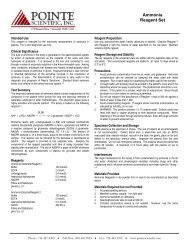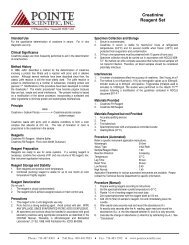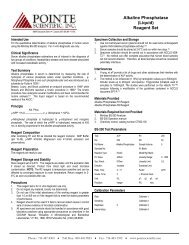12-HB936-156 - Pointe Scientific, Inc.
12-HB936-156 - Pointe Scientific, Inc.
12-HB936-156 - Pointe Scientific, Inc.
You also want an ePaper? Increase the reach of your titles
YUMPU automatically turns print PDFs into web optimized ePapers that Google loves.
Direct BilirubinReagent SetIntended UseFor the quantitative determination of direct bilirubin in serum using theMindray BS-200 analyzer. For in vitro diagnostic use only.Method HistorySince the introduction of the diazo method for bilirubin determination byEhrlich in 1883, 1 several modifications have been proposed to enhance thereaction. The Malloy and Evelyn method 2 employs methanol to catalyze theazo-coupling reaction of the indirect Bilirubin, as well as to keep theazobilirubin in solution. A serious disadvantage of this method lies in the factthat protein may be precipitated by the methanol solution to yield falselylowered results.In 1938, Jendrassik and Grof. 3 presented an assay that gave reliable results.The method is, however, cumbersome and involves several pipetting steps.The method presented here was developed by Wahlefeld et al. 4 The diazoreagent is 2,5-dichlorophenyldiazonium tetrafluoroborate (DPD) which reactsvery rapidly in coupling with Bilirubin under acidic conditions. The resultingprocedure is simple, yet exhibits good correlation when compared with themethod of Jendrassik and Grof.PrincipleDirect Bilirubin is coupled with a diazonium salt (DPD) in a strongly acidmedium (pH 1 – 2).acidBilirubin + DPD ------------------ AzobilirubinThe intensity of the color of the azobilirubin produced is proportional to theDirect Bilirubin concentration and can be measured photometrically.Reagents1. Direct Bilirubin R1 reagent: acid buffer 50 mmol/L2. Direct Bilirubin R2 reagent: acid buffer >30 mmol/L, >2.0 mmol/L DPDand stabilizersPrecautions1. Reagents are toxic and corrosive. Do not pipette by mouth. Avoidcontact with skin and clothing.2. This reagent is for in vitro diagnostic use only.Reagent PreparationReagents are supplied ready to use.Reagent Storage1. Packaged reagents may be stored at 2-8°C. The reagent is stable untilthe expiration date appearing on the label when stored as directed.2. Do not freeze reagents.3. Avoid exposure to direct sunlight.Reagent Deterioration1. Do not use if reagents show evidence of microbial contamination(turbidity).2. If the R2 develops very slight precipitation that re-dissolves when theR2 is warmed gently, the reagent may be used.3. R2 reagent containing a precipitate that does not re-dissolve andresults in product discoloration should not be used.4. Do not use if reagent fails to achieve assigned assay values of freshcontrol sera.Specimen Collection and Storage1. Fresh, unhemolyzed serum is recommended. 52. Samples should be analyzed within two hours of collection if kept at roomtemperature in the dark and within twelve hours if kept refrigerated (2-8°C)and protected from light. 63. Bilirubin in serum is stable for three months when stored frozen (-20°C) andprotected from light. 64. Direct sunlight may cause up to a 50% decrease in bilirubin within one hour. 75. Specimen collection should be carried out in accordance with NCCLS M29-T2. No method can offer complete assurance that human blood samples willnot transmit infection. Therefore, all blood samples should be consideredpotentially infectious.Interferences1. All interference studies were performed according to the proceduresrecommended in NCCLS guideline No. EP7-P for interference testing inclinical chemistry. 82. Serum hemoglobin levels up to 100 mg/dl do not interfere with results.3. Serum Triglycerides up to 500 mg/dl do not interfere with results.4. A number of drugs and substances affect bilirubin results. See Young, et al. 9Materials ProvidedDirect bilirubin reagents R1 and R2Materials Required but not Provided1. Mindray BS-200 Analyzer.2. BS-200 Operation manual.3. Chemistry Calibrator, catalog number C7506-504. Chemistry control, catalog number C7592-100Mindray BS-200 Test ParametersTest : DBIL R1 : 250No.: 006 R2 : 65Full Name: Direct Bilirubin Sample Volume: 6Standard No.:R1 Blank:Reac. Type: Endpoint Mixed Rgt. Blank:Pri. Wave: 546nm Linearity Range: 10.0Sec. Wave 670nm Linearity Limit:Direction: <strong>Inc</strong>rease Substrate Limit:Reac. Time: -1 / 19 Factor:<strong>Inc</strong>uba. Time: 3 □ Prozone checkUnit: mg/dl q1: q2: q3: q4:Precision: 0.1 PC: Abs:Calibration ParametersRule: Two-point linear Calibrator 1: Deionized WaterSensitivity: Calibrator 2: Chem CalReplicates: 2 Calibrator 3:Interval (day): Calibrator 4:Difference Limit: Calibrator 5:SD: Calibrator 6:Blank Response:Error Limit:Correlation Coefficient:Phone: 734-487-8300 • Toll Free: 800-757-5313 • Fax: 734-483-1592 • www.pointescientific.com
Direct BilirubinReagent SetPediatric VolumesFor pediatric samples with bilirubin over 3.0 mg/dl, run a 1:1 dilution withsaline. Multiply result by two.CalibrationUse an NIST-traceable serum calibrator. Follow instrument applicationinstructions for calibration. Refer to instrument manual instructions forcalibration procedures and frequency. It is recommended that eachlaboratory determine its own frequency of calibration.Quality ControlThe validity of the reaction should be monitored by use of the control serawith known normal and abnormal direct bilirubin values. These controlsshould be run at least with every working shift in which direct bilirubin assaysare performed. It is recommended that each laboratory establish its ownfrequency of control determination. Quality control requirements should beperformed in conformance with local, state, and/or Federal regulations oraccreditation requirements.Calculations (Example)Abs. = AbsorbanceUnk. = UnknownCal. = CalibratorWithin DayDay to DayMean S.D. C.V.% Mean S.D. C.V.%0.48 0.05 10.1 0.39 0.05 <strong>12</strong>.81.92 0.09 4.5 1.91 0.11 5.8References1. Ehrlich, P., Charite Ann. 8:140(1883).2. Malloy, H.T., Evelyn, K.A., J. Biol. Chem. 119:481 (1937).3. Jendrassik, L., Grof, P., Biochem. Zeitschr. 297:81 (1938).4. Wahlefeld AW, et al. Scand J Clin Lab Invest. 29 Supplement <strong>12</strong>6(1972).5. Michaelsson, M. Scand. J. Clin. Lab. Invest (Suppl. 49) 13:1 (1961)6. Martinek, R.G., Clin. Chem. Acta 13:161 (1966).7. Tietz, N.W. Fundamentals of Clinical Chemistry, Philadelphia, W.B.Saunders, P. 1028 (1976).8. NCCLS document, “National Evaluation Protocols for Interference Testing”,Evaluation Protocol Number 7, Vol. 4, No. 8, (June 1984).9. Young, D.S., Effects of Preanalytical Variables on Clinical Laboratory Tests,Washington DC, AACC Press, (1997)10. NCCLS document, “Evaluations of Precision Performance of ClinicalChemistry Devices”, 2 nd Ed. (1992)11. Gambino, S.R., et al, Bilirubin Assay (Revised), Commission on ContinuingEducation, Am. Soc. of Clin. Path., Chicago, (1968).Abs. Unk. – Abs. Unk. Blank x Conc. of Cal. (mg/dl) = Direct Bilirubin (mg/dl)Abs. Cal. – Abs. Cal. BlankSample: If Abs. of Unknown = 0.35, Abs. of Unknown Blank = 0.01, Abs. ofCalibrator 0.25, Abs. of Calibrator Blank = 0.01, Concentration of Calibrator =4.0 mg/dlThen: 0.35 – 0.01 x 4 = 0.34 x 4 = 5.7 mg/dl0.25 – 0.01 0.24Expected Values (Direct) 7,11Adults and infants (over one month): 0 – 0.5 mg/dlIt is strongly recommended that each laboratory establish its own normalrange.Rev. 2/13 P803-<strong>HB936</strong>-MINLimitations1. Samples with values above 10 mg/dl must be diluted 1:1 with isotonicsaline, re-assayed and the final answer multiplied by two.2. Serum hemoglobin levels of up to 100 mg/dl and triglyceride to 500mg/dl do not interfere with results.Performance1. Linearity: 10.0 mg/dl2. Limit of Detection (Sensitivity): 0.1 mg/dl3. Comparison: A study was performed between the Mindray BS-200 anda similar analyzer using this method, resulting in a correlationcoefficient of 0.999 with a regression equation of y=0.985x - 0.<strong>12</strong>.4. Precision: Precision studies were performed using the Mindray BS-200analyzer following a modification of the guidelines which are containedin NCCLS document EP5-T2. 10



